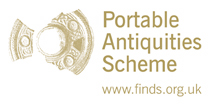File:Bronze Age unidentified object (FindID 653805).jpg

Original file (4,977 × 2,120 pixels, file size: 1.72 MB, MIME type: image/jpeg)
Captions
Captions
Summary
[edit]| Bronze Age unidentified object | |||
|---|---|---|---|
| Photographer |
St. Albans District Council, Julian Watters, 2014-12-05 14:20:40 |
||
| Title |
Bronze Age unidentified object |
||
| Description |
English: Slender leaf-shaped gold strip, the ends folded over to form a distorted ring. Both ends are pierced; the two holes were executed from opposite sides of the strip. While one end is intact and tongue-shaped, the other is squared off and may retain the very slight trace of an original piercing or other feature. It is possible that this end was broken, re-pierced and roughly fettled. The hole at this end is blocked with soil.
Length 19.8mm; maximum width of strip 13.9mm; thickness 0.9mm; weight 2.17 grams. Non-destructive X-ray fluorescence analysis of the surface of the pierced metal strip, performed by the British Museum's Scientific Research section, indicated a gold content of approximately 87-89 %, a silver content of approximately 10-11%, and approximately 1% copper. There is a range of gold strip and ribbon ornaments datable to the British Bronze Age. The less numerous types include arm and possibly ear ornaments fastening by means of a hook at each end, or a hook and eye (piercing). There are good analogues in the French Middle Bronze Age. There are also an increasing number of (often) thin gold strips and fragments with terminal piercings which on grounds of composition could fit into a Bronze Age context. Again, there are continental analogues, beginning within the Early Bronze Age sheet gold tradition. The piece under discussion here is best compared with the pair of gold ornaments from Binstead, West Sussex; these have hook and eye fastenings. They are datable to the Middle Bronze Age, about 1500-1300BC. (Treasure Annual Report 1998-1999). |
||
| Depicted place | (County of findspot) Oxfordshire | ||
| Date | between 1500 BC and 800 BC | ||
| Accession number |
FindID: 653805 Old ref: BH-1BE953 Filename: BA_gold_2014_T.JPG |
||
| Credit line |
|
||
| Source |
https://finds.org.uk/database/ajax/download/id/495772 Catalog: https://finds.org.uk/database/images/image/id/495772/recordtype/artefacts archive copy at the Wayback Machine Artefact: https://finds.org.uk/database/artefacts/record/id/653805 |
||
| Permission (Reusing this file) |
Attribution-ShareAlike License version 4.0 (verified 29 November 2020) | ||
Licensing
[edit]- You are free:
- to share – to copy, distribute and transmit the work
- to remix – to adapt the work
- Under the following conditions:
- attribution – You must give appropriate credit, provide a link to the license, and indicate if changes were made. You may do so in any reasonable manner, but not in any way that suggests the licensor endorses you or your use.
- share alike – If you remix, transform, or build upon the material, you must distribute your contributions under the same or compatible license as the original.
File history
Click on a date/time to view the file as it appeared at that time.
| Date/Time | Thumbnail | Dimensions | User | Comment | |
|---|---|---|---|---|---|
| current | 07:00, 2 March 2019 |  | 4,977 × 2,120 (1.72 MB) | Fæ (talk | contribs) | Portable Antiquities Scheme, BH, FindID: 653805, bronze age, page 7492, batch count 18079 |
You cannot overwrite this file.
File usage on Commons
The following page uses this file:
Metadata
This file contains additional information such as Exif metadata which may have been added by the digital camera, scanner, or software program used to create or digitize it. If the file has been modified from its original state, some details such as the timestamp may not fully reflect those of the original file. The timestamp is only as accurate as the clock in the camera, and it may be completely wrong.
| Orientation | Normal |
|---|---|
| Horizontal resolution | 275 dpc |
| Vertical resolution | 275 dpc |
| Software used | Adobe Photoshop Elements 3.0 Windows |
| File change date and time | 13:51, 5 December 2014 |
| Color space | Uncalibrated |
